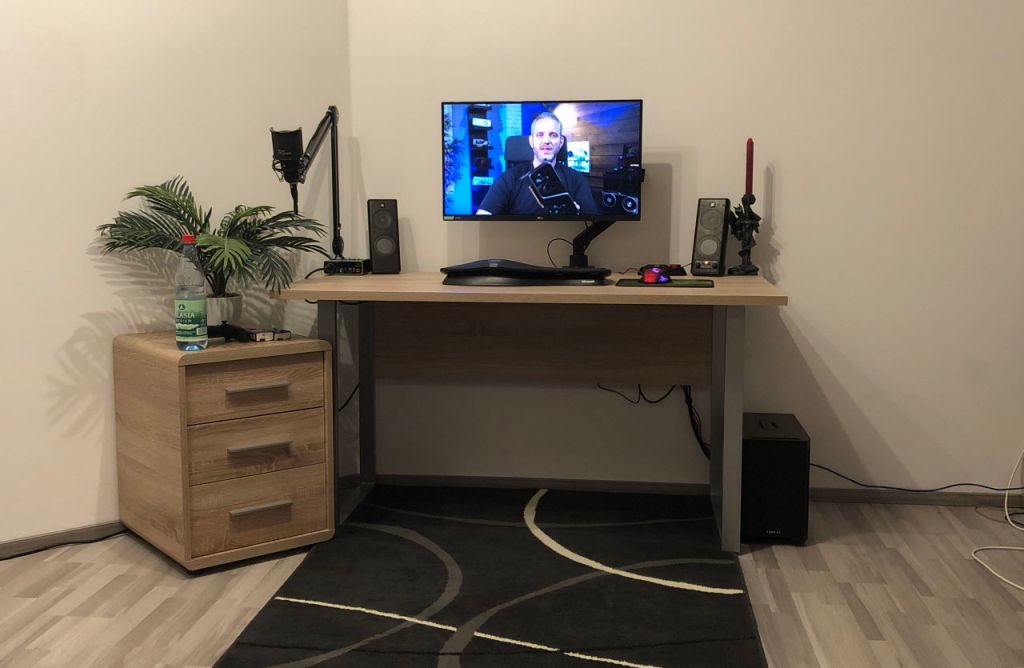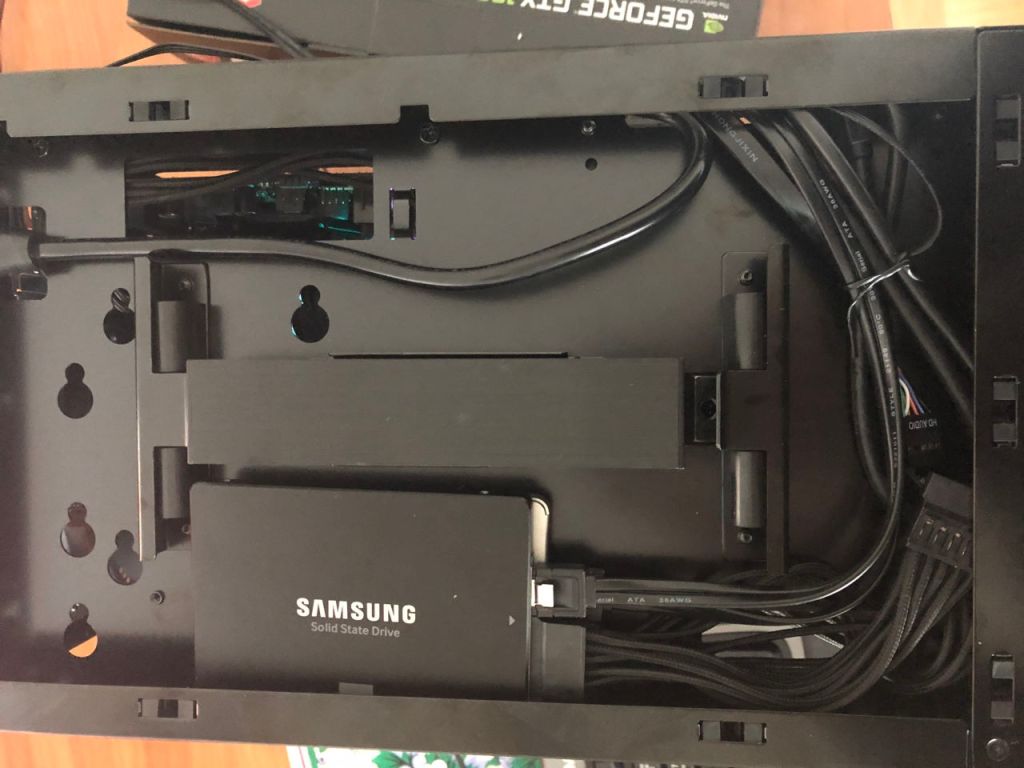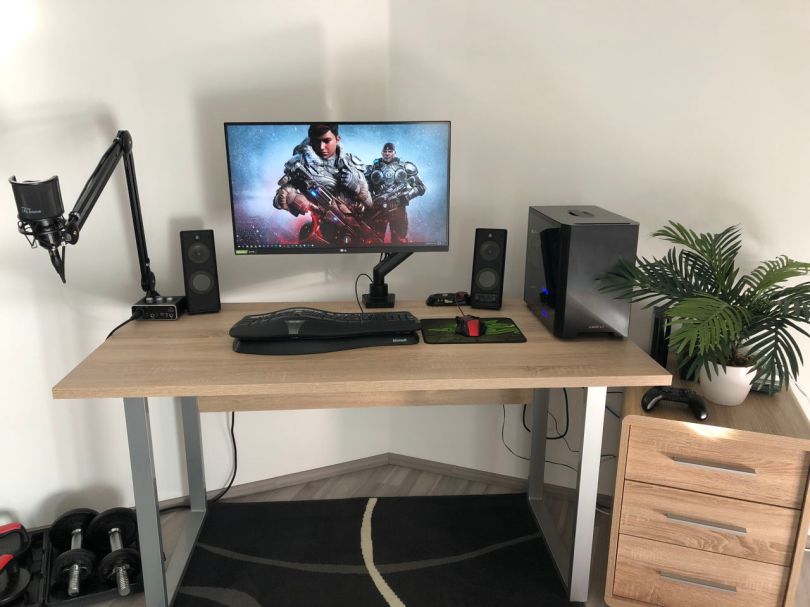In a few aspects, the Lian Li TU150 is comparable to the NZXT H200. One: for an ITX enclosure, it is on the bigger side. And two: it has a similarly closed-off front. Other than that, they are pretty different, though. In some areas, that is a good thing, and it is a bad thing in others.
In the timeframe of just over a year, this is the fourth (!) computer case that I have tried. Usually, it is the CPU or GPU that gets replaced more often 😅 It is also my current case, which means I can provide good pictures to visualize my thought process better.

Here is how the case looks when you put it on the floor, like you would with a mid-tower PC.

Design
At first glance, this little puppy is gorgeous. On the outside, everything is either brushed aluminum or glass. The matte black looks stunning, and the build quality is excellent. I expect nothing else from Lian Li because quality aluminum cases have always been their specialty, and the TU150 fits right into this legacy. One of the excellent features it has over the NZXT H200 is a nicely integrated carrying handle. If you need it, pop it out. Otherwise, fold it back into the top, and it sits flush with the panel. This handle is perfect if you frequently carry your computer around, even if it is just from the desk to your TV, for example.
Another "feature" concerns the window side panel. To provide a bit of context: the SFX power supply is mounted to the top, right behind the front panel. The glass panel has an extended screen to hide the power unit and the wires connecting to it. At first thought, this seems like a good idea. Now that I have lived with the TU150 for a while, I wouldn’t say I like it that much.
One apparent reason is that it destroys all aspects of symmetry. Usually, the glass is surrounded by an evenly sized frame, but now there is a big black blob in the upper right-hand corner. However, the biggest flaw in this construction is the two different black shades in play here. There is a black frame inside the glass panel, a single aluminum piece that wraps around the edges and has this screen to hide the power supply. It is of the same matte black as the other pieces – which should be good. Then there is another layer of black right underneath the glass surface that goes around the panel’s edges, but this time it is an even rectangular frame. This frame has a much deeper black and makes the aluminum on the inside look pale in comparison.

I think this is the wrong design decision. I do not mind the darker and richer black of the outer frame, quite the contrary. To me, it looks great. It is the inner view-blocker that I have an issue with. It seems like Lian Li bolted it on at the last minute. Somebody looked at the case and thought, "Shoot, I can see the hard drive and the power supply. We must hide that somehow, quickly! This is ugly."
It is ugly now, too, and guess what, not only does it look like a foreign substance invaded the inside of my case, from where I am sitting, it also blocks the view to components like the RAM and part of the CPU cooler. Imagine you invested a fortune in G.Skill Trident Z Royal memory and could not see it correctly. The embarrassment.
In short: the side panel is not the best-looking element, and for cooling, the slightly perforated solid aluminum panel is likely the better choice.
With that out of my system, I can accept that this is a complaint on a high level. Overall, the Lian Li TU150 looks very elegant. The glass side panel surely catches your eye, despite the additional view screen.
Compatibility & Experience
The one huge advantage the TU150 has over the NZXT H200 is graphics card support. The official specification states that 2.5 slot models of up to 320mm in length will fit. The case has three slots, though, and there is additional space underneath the third slot for some excessive cooler designs. I’d love to try a triple-slot high-end pixel accelerating monster like the NVIDIA RTX 3090, and I am confident it would fit. It might be necessary to forgo a front intake fan, though.
That was an extended version of saying that the case has a lot of room for components. It should even fit Noctua’s mighty NH-D15, the gold standard for big air coolers, with 165mm of maximum supported cooler height. As I have alluded to earlier, Lian Li has even found some room to hide away a mechanical 3.5-inch hard drive. You can mount one of those relics right above the CPU cooler, upside-down like a bat. The only thing missing is support for a 5.25-inch optical drive, or maybe a slim version, and the TU150 would beat the Fractal Design Core 500 for compatibility on all fronts.
Not everything is nice and shiny, though. I am not a fan of the mounting system for hard drives, no matter the size. It is toolless, granted. But I would have preferred to secure at least my mechanical hard drive with four screws. Instead, you add rubber thingies to your device and then slot it into cut-outs in the metal.
That approach may be good enough for SATA SSDs; heck, I put mine in the carrying handle’s lair in the top compartment. But a mechanical drive? That is mounted upside down? In a case with a carrying handle that invites you to transport the enclosure from A to B? Not a fan.

Another thing I have noticed with regards to drive mounting is too small cut-outs for cable routing. Once your storage device is in place, it needs a SATA connection and some power, at least mine do, and the power connector is ever-slightly too big to fit onto the drive comfortably and through the opening in the case. Or, the other way around, the hole is too small for a regular power connector. Even the SATA cable is a tight fit.

Speaking of cables: the front USB connector cable is of the blue-pill kind. Very stiff, few bending. I had a hard time getting that connector onto the motherboard and make it stay there. You have to remember, it needs to do a 180 to go behind the motherboard, and there it must do another 90-degree turn to hide between the mainboard tray and side panel. That is a lot of tight bends without much space to perform them. On the plus side, you get a USB-C front connector – if you have a motherboard that supports it.
Apart from that, building in the Lian Li TU150 is reasonably enjoyable. It is a relatively large ITX case, which gives you more room than an extremely space-optimized chassis to work in. The top compartment that hides the handle can even serve as a cable channel if your power supply comes equipped with long cables. Corsair’s SFX line does not, and Seasonic’s Focus SFX-L does not either, so I could not make use of that feature. However, I did cram two SATA SSDs into the case’s attic because there was no way to fit them somewhere otherwise since they’re dangling off the same power cable.
Another issue I noticed has to do with the M.2 mounting location on my motherboard. ASRock decided to include it on the back of the board, and the cut-out for the CPU socket is slightly too small so that I could comfortably insert the SSD without disassembling the computer. It is not the fault of the case, but something I have noticed.
Cooling
You can mount two additional fans, one on the front for intake and another in the back for exhaust. In this aspect, the H200 has an advantage as it allows you to mount two rear exhaust fans. The second one goes into the top above the CPU cooler. This way, heat will be removed from the inside of the case much quicker than with just one fan.
There are a few design decisions by Lian Li that make this impossible. For one, you can mount storage drives to the top. Second, there is the additional compartment for the handle, and third, it would destroy the clean and minimalistic look of the case if it had perforations in the top panel. In my opinion, remove the handle, use the new-found space for storage mounting options, and add a fan to the top.
Airflow is not bad, but you can mount power-hungry hardware in this enclosure, and that will produce a lot of heat. A single fan in the rear may not be able to remove all of that hot air fast enough – unless you set it to 100% fan speed and enjoy the noise.
Lian Li has done well to add many holes for ventilation at the bottom of the case. You can either mount additional fans to actively flood the GPU with cold air or expect the graphics card cooler to manage the intake independently. Either way, the GPU has plenty of supply to cold air. If there were only a way to remove it all quickly 😉 After a gaming session, the top gets noticeably warm to the touch. It is not hot, but definitely warm. A hard drive will feel very cozy up there.
With that being said, my mid-range hardware does not get toasted to death. The CPU is somewhere between 50 and 60 degrees, and the MSI 1660 Super works at its maximum temperature with the fans doing what they can. At 1080p, the card is silent enough, but at 1440p, which it has to push for a few months now, it gets very noticeable.
I would say that cooling potential is average because you cannot mount another top exhaust fan. Other than that, you can install two case fans, graphics cards with big coolers, and also large CPU coolers. Another thing where this case falls short compared to the NZXT H200 is water cooling. You may be able to fit a 120mm AiO in the front or back, but it will be a very tight fit. The H200 can support at least a 240mm All-in-One liquid cooler in the front. In my opinion, this case is best used for air cooling, and it looks much more impressive with a ginormous Noctua monstrosity that fills out the case.
If you run your hardware at stock settings, maybe a slight overclock or a strong overclock on an otherwise efficient CPU or GPU, this case will handle almost everything well enough. For an ITX chassis, it offers good cooling options, with only one glaring omission due to design choices.
Pricing & Availability
At around 105€, the Lian Li TU150 is a good entry into the ITX space. There is no price difference between the windowed version and the one with a solid side panel. Availability is good, too – at least in Germany. It probably is almost everywhere since Lian Li is not a niche manufacturer. They are a well-known brand and have established themselves in the market, just like NZXT or Fractal Design. On that front, there is not much more to say.
Final Thoughts
To put it short: the Lian Li TU150 is a fantastic mini ITX enclosure. It supports a lot of powerful hardware and the big coolers that come with it, and you can also add quite a bit of storage once you get creative. As of right now, I have one 3.5-inch HDD, two 2.5-inch SSDs, and an M.2 PCIe NVME SSD installed.
Despite the faux pas with the side window, it still looks incredible. The matte black brushed aluminum is stunning – and a fingerprint magnet, sadly. Compared to the Meshify C, a full ATX mid-tower, the TU150 is tiny. During my research, I performed several measurements, and all concluded that the most significant gain would come from a smaller height. Width and length were not that different, maybe one ore two centimeters here or there, nothing major. But seeing both cases side by side shows a very different picture. Yes, the Lian Li TU150 is a big ITX case. However, next to a regular-sized computer tower, it is adorable. Its biggest competitor is probably the NCase M1 and lately the Cooler Master NR200.

On the other hand, the Ncase M1 costs twice as much, and it is hard to get your hands on. You cannot mount as big CPU coolers in the NCase M1, but it has better ventilation, though, and a much more space optimized construction, making it even smaller. The M1 is my favorite, and if it weren’t for the pandemic and the supply and shipping issues it caused, I would have probably ordered one. Sadly, these cases are only shipped to very few locations right now, and Germany is not among them.

[…] Lian Li TU150 […]
LikeLike